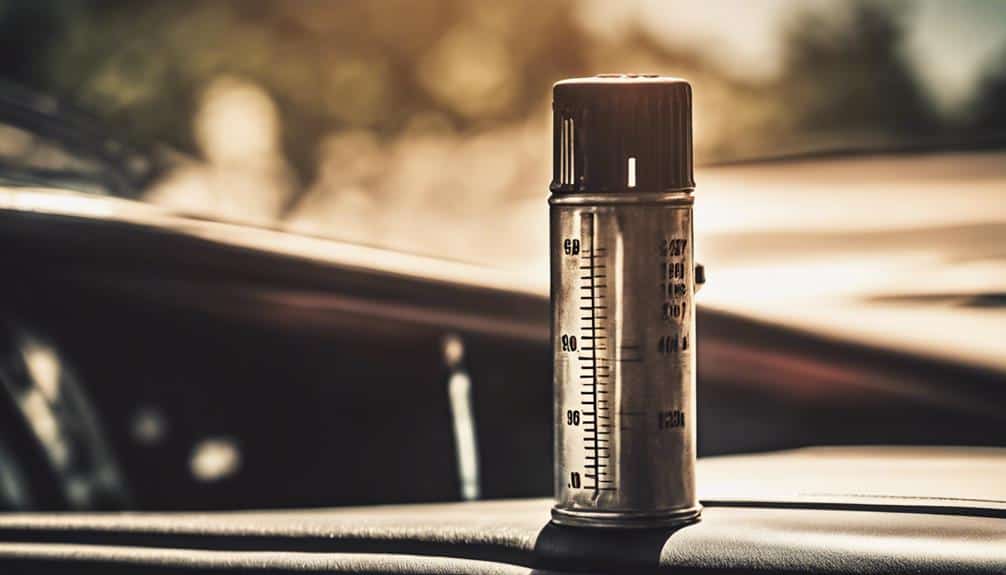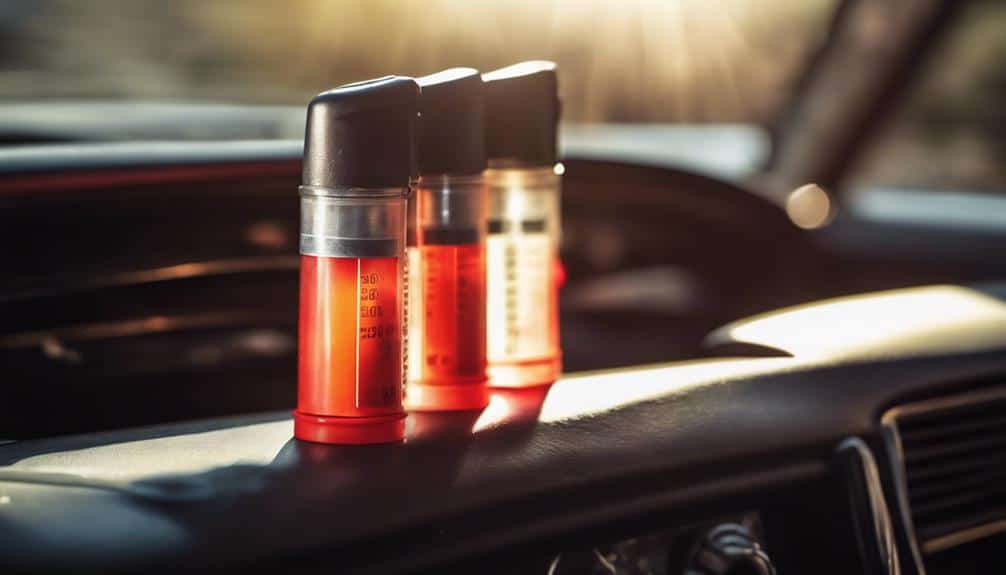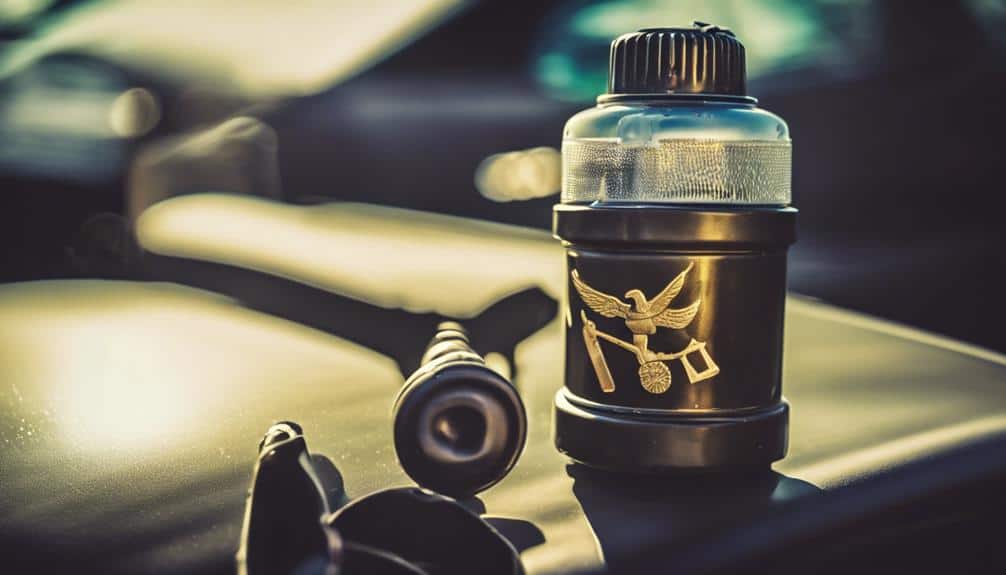Can Pepper Spray Be Kept in a Hot Car?
Keeping pepper spray in a hot car is risky business! When temperatures rocket beyond 120°F, that little canister could spring leaks or, worst-case scenario, explode—definitely not something you want to happen while you’re driving. It’s better to stash it in the glove compartment or under a seat where it’s cooler and out of direct sunlight, trying an insulated bag might even save you some worry. Leaks aren’t fun, and neither is burning your leg on a red-hot can! Regularly check for damage and keep an eye on the expiration date to avoid nasty surprises. Stick around to uncover more tips.
 Understanding the temperature guidelines for storing pepper spray is essential for guaranteeing its effectiveness and safety. You might think that keeping pepper spray in your car is convenient, but extreme heat can be a real problem. Pepper spray canisters shouldn’t be exposed to temperatures above 120°F (48.88°C). If they are, you risk leaks or even explosions—definitely not something you want to deal with on a hot day! The Pepper Shot 1.2% MC is particularly sensitive to temperature changes, given its compact design and potent ingredients.
Think about your car on a scorching summer day. Interior temperatures can skyrocket past 120°F, especially if it’s parked in direct sunlight. This makes places like the dashboard or door panels terrible spots for storing pepper spray. You don’t want to open your car door only to find a pepper spray disaster waiting for you.
To keep your pepper spray effective and safe, store it in a cool, dry place. Ideally, somewhere below 120°F and above -5°F (-20.56°C). Also, remember to regularly check your canister for any signs of wear and tear, and don’t forget those expiration dates! Keeping these guidelines in mind will guarantee your pepper spray is ready to protect you when you need it most.
Understanding the temperature guidelines for storing pepper spray is essential for guaranteeing its effectiveness and safety. You might think that keeping pepper spray in your car is convenient, but extreme heat can be a real problem. Pepper spray canisters shouldn’t be exposed to temperatures above 120°F (48.88°C). If they are, you risk leaks or even explosions—definitely not something you want to deal with on a hot day! The Pepper Shot 1.2% MC is particularly sensitive to temperature changes, given its compact design and potent ingredients.
Think about your car on a scorching summer day. Interior temperatures can skyrocket past 120°F, especially if it’s parked in direct sunlight. This makes places like the dashboard or door panels terrible spots for storing pepper spray. You don’t want to open your car door only to find a pepper spray disaster waiting for you.
To keep your pepper spray effective and safe, store it in a cool, dry place. Ideally, somewhere below 120°F and above -5°F (-20.56°C). Also, remember to regularly check your canister for any signs of wear and tear, and don’t forget those expiration dates! Keeping these guidelines in mind will guarantee your pepper spray is ready to protect you when you need it most.
 To keep your pepper spray safe in a hot car, consider storing it in the center console or glove compartment. These areas shield it from direct sunlight and extreme temperatures, reducing the risk of the canister failing. You don’t want your pepper spray turning into a mini time bomb, right? Another smart option is using insulated bags or cases. These storage solutions further protect your pepper spray from high heat, preventing leaks or bursts due to pressure changes. Imagine enjoying a sunny day, only to find out your pepper spray has exploded in your car. Not fun!
Additionally, the Pepper Shot features a locking actuator for safety during transport, ensuring it doesn’t accidentally discharge. Regularly checking the integrity and expiration date of your pepper spray is also essential. After long periods in a vehicle, make sure it’s still functional. Trust me, you don’t want to rely on pepper spray that’s gone bad.
Avoid storing it in areas with extreme temperature fluctuations, like door panels. Over time, these spots can degrade the product. Instead, consider using a holster or keychain. These allow easy access while keeping the canister protected from environmental stressors during travel.
To keep your pepper spray safe in a hot car, consider storing it in the center console or glove compartment. These areas shield it from direct sunlight and extreme temperatures, reducing the risk of the canister failing. You don’t want your pepper spray turning into a mini time bomb, right? Another smart option is using insulated bags or cases. These storage solutions further protect your pepper spray from high heat, preventing leaks or bursts due to pressure changes. Imagine enjoying a sunny day, only to find out your pepper spray has exploded in your car. Not fun!
Additionally, the Pepper Shot features a locking actuator for safety during transport, ensuring it doesn’t accidentally discharge. Regularly checking the integrity and expiration date of your pepper spray is also essential. After long periods in a vehicle, make sure it’s still functional. Trust me, you don’t want to rely on pepper spray that’s gone bad.
Avoid storing it in areas with extreme temperature fluctuations, like door panels. Over time, these spots can degrade the product. Instead, consider using a holster or keychain. These allow easy access while keeping the canister protected from environmental stressors during travel.
 Maneuvering the legal terrain of pepper spray possession is essential to guarantee you’re compliant with state laws. First, check your state’s specific rules. Some places require a license to carry certain brands or types of pepper spray. Imagine thinking you’re safe and legal, only to find out you’ve broken the law! For instance, carrying Wildfire Pepper Spray might necessitate specific permissions in certain states.
In many states, you need to be at least 18 to carry pepper spray. But age restrictions can vary, so double-check your local laws. And don’t forget, there are often limits on the size and strength of the canisters you can legally have. It might seem like a minor detail, but it can make all the difference.
Planning a road trip? Research the laws of each state you’ll pass through. Transporting pepper spray across state lines can get tricky, and you don’t want a legal mishap ruining your trip.
Lastly, know when you can legally use pepper spray for self-defense. Some states have specific rules about when it’s okay to pepper someone. Before relying on it for protection, make sure you’re clear on these laws. Stay informed, and you’ll stay out of trouble!
Maneuvering the legal terrain of pepper spray possession is essential to guarantee you’re compliant with state laws. First, check your state’s specific rules. Some places require a license to carry certain brands or types of pepper spray. Imagine thinking you’re safe and legal, only to find out you’ve broken the law! For instance, carrying Wildfire Pepper Spray might necessitate specific permissions in certain states.
In many states, you need to be at least 18 to carry pepper spray. But age restrictions can vary, so double-check your local laws. And don’t forget, there are often limits on the size and strength of the canisters you can legally have. It might seem like a minor detail, but it can make all the difference.
Planning a road trip? Research the laws of each state you’ll pass through. Transporting pepper spray across state lines can get tricky, and you don’t want a legal mishap ruining your trip.
Lastly, know when you can legally use pepper spray for self-defense. Some states have specific rules about when it’s okay to pepper someone. Before relying on it for protection, make sure you’re clear on these laws. Stay informed, and you’ll stay out of trouble!
Temperature Guidelines

User Experiences
While knowing the temperature guidelines is important, real-life user experiences provide valuable insights into storing pepper spray in cars. Many users have shared their stories, and it’s a mixed bag of outcomes. Some folks swear by keeping their MACE pepper sprays in their hot cars for months without a hitch. They say it’s reliable even when the temperatures outside soar. For those who prefer a more hands-on approach, the Mace Pepper Spray Jogger is designed for easy carrying during outdoor activities, which might make it more versatile in different storage conditions. You might find it handy to store your pepper spray in the door shelves of your car. Several users do this and report no issues, though they admit it’s a bit of a gamble with the temperature fluctuations. However, don’t forget to check the canister’s integrity and expiration dates regularly to confirm it’s still effective. Now, not everyone gets off scot-free. Some people have had their pepper sprays accidentally go off in confined spaces, which is definitely a situation you want to avoid. Imagine the chaos! Also, freezing temperatures could potentially mess with the spray’s performance, so keep that in mind if you live in a colder area. While experiences vary widely, paying attention to these tips might save you from some pepper spray drama in your hot car.Storage Solutions

Safety Precautions
When considering the safe use of pepper spray, especially in a hot car, you need to be mindful of how high temperatures can affect its performance and safety. It’s essential to understand that pepper spray should not be stored in vehicles where temperatures can exceed 120°F. High heat can cause leaks or even bursts in the canister, turning a handy defense tool into a potential hazard. To keep your pepper spray safe, regularly check the can for any signs of deformation or damage. High temperatures can warp the canister, making it unreliable when you need it most. A good habit is to store your pepper spray in a shaded or insulated area of your car. Avoid placing it in direct sunlight, as this can increase internal pressure and the risk of explosion. Here’s a quick guide to help you remember these important safety precautions:| Precaution | Why It’s Important | How to Implement |
|---|---|---|
| Avoid High Heat | Prevents leaks and bursts | Store below 120°F |
| Check Integrity | Guarantees canister reliability | Look for damage regularly |
| Use Shaded Areas | Reduces temperature exposure | Keep out of direct sunlight |
| Insulate Storage | Mitigates heat risks | Use insulated bags |
| Test Potency | Verifies effectiveness | Regularly test spray |
Legal Considerations

Frequently Asked Questions
Does Pepper Spray Go Bad in Heat?
Yes, pepper spray degrades in heat. Heat exposure effects include diminished potency and reliability. Exposing it to high temperatures can cause leaks or bursts, compromising its effectiveness in emergencies. Regularly check and replace your canister to guarantee safety.Does Pepper Spray Go Bad if Left in the Car?
Yes, pepper spray goes bad if left in the car. High temperatures shorten pepper spray shelf life and may cause leaks or bursts. Always follow car safety precautions by storing it in a cooler, stable environment.What Is the Maximum Temperature for Pepper Spray?
Imagine your pepper spray as delicate as a potion from an alchemist. The maximum temperature for storing it is 120°F. Exceeding this compromises the pepper spray’s composition and effectiveness, potentially causing leaks or dangerous bursts.Where Is the Best Place to Store Pepper Spray?
For safe storage, keep your pepper spray in the glove compartment or central console. These areas protect it from heat. Consider pepper spray alternatives like keychain attachments for quick access and reduced exposure to temperature fluctuations.
Facebook
Twitter
LinkedIn
Pinterest
X
Joseph Lombardi
Joseph Lombardi is an esteemed Army combat veteran whose valor and leadership were honed during Operation Iraqi Freedom. His military career is marked by exemplary service and dedication, earning him numerous commendations for bravery and tactical prowess. Transitioning from the battlefield to the business world, Joseph channeled his extensive experience into founding Para Bellum Defense, a premier self-defense products company.
As the owner and CEO of Para Bellum Defense, Joseph brings a unique blend of military discipline and strategic acumen to the forefront of the self-defense industry. His company specializes in innovative and reliable products designed to empower individuals and ensure their safety in an increasingly uncertain world. Under his leadership, Para Bellum Defense has rapidly gained a reputation for excellence, driven by Joseph's unwavering commitment to quality and customer satisfaction.
In addition to his entrepreneurial success, Joseph boasts a decade-long career in executive protection and security. His expert skills in threat assessment, risk management, and personal protection have made him a sought-after professional in the field. Joseph's dedication to safeguarding others extends beyond his professional endeavors, as he actively participates in community outreach programs aimed at promoting safety and self-defense awareness.
With a firm belief in preparedness and empowerment, Joseph Lombardi continues to inspire and protect, embodying the true spirit of a warrior and a guardian.
Tagged Pepper Spray

